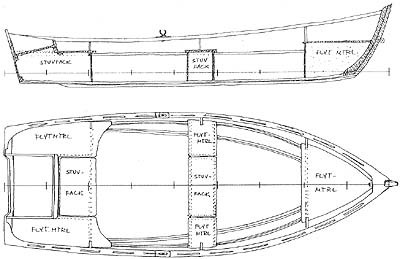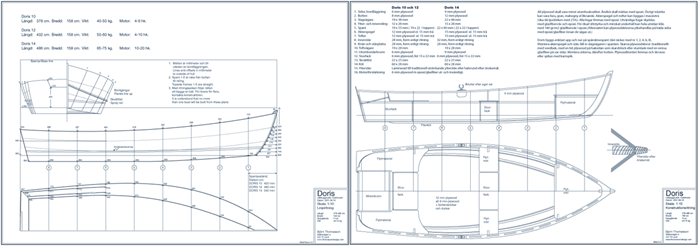Doris – a simple plywood dory
Latest updated Friday, October 25, 2024, 16 comments
Images | Particulars | Background and history

Plans, Doris – a simple plywood dory - 135 EUR
Purchase
images | information | lines | particulars | history
Doris is what the American dory was called when it appeared on the Swedish Westcoast. In the hands of wilful Swedish boat builders, it soon lost most traces of its origin, and instead, a simple and versatile workboat evolved - known as "plattbonning" or "skjöddel". It gained instant popularity around the coast since it is easily rowed, shallow, seaworthy, tough, cheap and easily built, even by non-boatbuilders.
 My "Doris" has gained a little volume aft, to carry an OB with dignity and speed. Unfortunately, this detracts a little from the rowing qualities. You can not have it all. The OB well reduces the risk of water entering over the transom (especially with a short rig OB) and moves crew weight forward. With ample flotation, Doris is unsinkable. The sizes are feet on the bottom board - a nostalgic tip of the hat to the original dories.
My "Doris" has gained a little volume aft, to carry an OB with dignity and speed. Unfortunately, this detracts a little from the rowing qualities. You can not have it all. The OB well reduces the risk of water entering over the transom (especially with a short rig OB) and moves crew weight forward. With ample flotation, Doris is unsinkable. The sizes are feet on the bottom board - a nostalgic tip of the hat to the original dories.
The hull can be built from full plywood panels, or, for a more traditional appearance, with three glued carvel planks. Pre-glued panels of wood strips is another option. The plans include a short advice for these options.
Three versions
Doris can be built in three sizes – all shown on the same plans.
Doris 10 is 378 cm long overall, weight approx 30-40 kg and can handle a small 4-6 HP OB motor.
Doris 12 is 432 cm long, weight approx 40-50 kg and can use a 4-10 HP OB motor.
Doris 14 is 486 cm long, weight approx 50-65 kg and can handle a 10-20 HP OB motor.
All three versions are 158 cm wide.
Images


Particulars

| Length |
378 – 432 – 486 cm |
| Beam |
158 cm |
| Weight |
40 – 50 – 65 kg |
| Engine |
4-6 HP – 4-10 HP – 10-20 HP |
Plans
The plans are two sheets (DIN A2): lines (metric scale 1:10) with all needed measurements, and construction (metric scale 1:10) with dimensions and a short building manual. This will be enough for most builders, but additional information may be found in some of the boat building books available from Amazon and others.
Since Doris has a flat bottom and straight sides you need just a couple of measurements for each mold, and between these straight lines. It is very easy to draw the station molds and also the slightly curved stem.

No building manual is included. For more information on building techniques, please consult one of the books on boat building listed in literature.
Plans, Doris – a simple plywood dory - 135 EUR
Purchase
Doris – background and history
A dory (Grand Banks dory) is a very simple and functional boat that was mass-produced for the Grand Banks fisheries off Nova Scotia during the first part of the twentieth century. The dories were nailed together of simple t&g boards, with a flat bottom and straight sides, often three boards and removable thwarts. The sizes were defined from 12 to 19 feet from the length of the bottom, and they stacked on the deck of the schooners on the way to and from the banks.
A stack of dories on the deck of Delawana II in Lunenburg 1943
 On the banks, the dories were launched with two or three fishermen in each. Those familiar with "Captains Courageous" from Rudyard Kipling's novel with among others Spencer Tracy, Lionel Barrymore, John Carradine know what it looked like (or at least what MGM would have it look like ;-). The fishermen hauled cod with handlines, transferred the load to the schooners, and when these were full it was a race back to Halifax or Gloucester. The winner got the best price. The bank schooners became the fastest sailing vessels of their time. The most famous – Bluenose – has been clocked for over 36 knots, as well as holding the record for the largest catch of fish ever brought into Lunenburg.
On the banks, the dories were launched with two or three fishermen in each. Those familiar with "Captains Courageous" from Rudyard Kipling's novel with among others Spencer Tracy, Lionel Barrymore, John Carradine know what it looked like (or at least what MGM would have it look like ;-). The fishermen hauled cod with handlines, transferred the load to the schooners, and when these were full it was a race back to Halifax or Gloucester. The winner got the best price. The bank schooners became the fastest sailing vessels of their time. The most famous – Bluenose – has been clocked for over 36 knots, as well as holding the record for the largest catch of fish ever brought into Lunenburg.
Between the fishing seasons, the boats were raced in International Fishermen's Trophy, with Bluenose winning 17 consecutive years – even against schooners built for racing only. When the schooners lost their importance on the banks, Bluenose had a few years in the tourist service in the West Indies, before hitting a reef off Haiti in 1946 and sinking. A replica was constructed, Bluenose II, from the original plans in 1963, but never reached the speed of Bluenose I*. Now, money is being raised for a Bluenose IV in an attempt to find the "soul" of the "real" Bluenose (Bluenose 3 was never built due to disagreements over the ownership of the name).

Bluenose off Halifax in 1930. Foto Mac Askill, Halifax

Under summer rigging (during winter the topmasts and light upper sails were left ashore) with all sails set: jib, flying jib, staysail, foresail, foretop, mainsail, main top, and fisherman (the fisherman is the large staysail set from the mainmast top). The photo is from Nova Scotia Archives and no information is available about the name of the schooner or the photographer.

An artists' depiction of a fishing scene. The image is from Nova Scotia Archives and no information is available.
The end is sad. The inexhaustible banks were hit during the 50s and 60s by modern floating fish factories, greed, and catastrophic political decisions – the ecosystem crashed and are dead submarine deserts today. According to leading scientists, they will probably never recover.
* There has been a lot of speculations over Bluenose's amazing speed. For the naval architect William Roué she was the one single stroke of luck – his later designs were nothing compared to Bluenose. One theory is that the builders made a mistake: the foreman on the yard that built the Bluenose in 1921, Carl Zinck admitted much later that the station molds in the forepart got mixed up, så that mold 5 was placed at station 4, mold 6 at station 5, etc. The architect was outraged and wanted everything torn down and rebuilt, but the contractor refused for economical reasons, and Bluenose was launched with too much volume in forepart. Roué declined publically all responsibility for the ship but changed his view when she began to embarrass everything on the North Atlantic. The theory is that the extra floatation allowed her to carry more sails without dipping the stem. Modern sailboat design has gone the same way – more volume in the stems for more speed.

